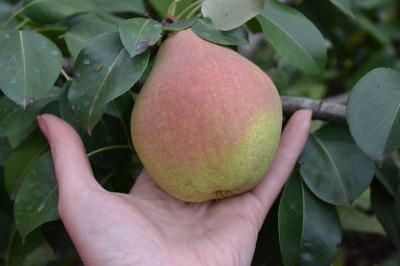
- Authors: Susov V.I.
- Year of approval: 2001
- Fruit weight, g: 200
- Ripening terms: late autumn
- Appointment: fresh
- Growth type: medium height
- Yield: high
- Crown: spherical, medium thickened
- Escapes: weakly whitening, powerful, thick, with short internodes (spur type), with a greenish-yellow color
- Fruit shape: rounded
Fruits are not only a delicious delicacy, but they are also very useful for the body. The complex of vitamins they replenish cannot be compared with any other supplement. Pear Autumn Susova not only has a pleasant taste, but is also rich in vitamins and useful microelements.
Breeding history
The development of culture began in 1995 in the village of Gorodnya, Moscow Region. The author-breeder was V.I.Susov.After the variety passed all the tests, it was allowed for use in 2001. There is still no information about which varieties were chosen for the parental pair.
Pear Autumn Susova is also known under a different name - Large-fruited Susova. Designed for cultivation in the Central region. But many gardeners grow crops in colder climates.
Description of the variety
The tree belongs to the medium-sized type. The height of the trunk together with the crown reaches only 5 m. The crown is of medium density, spherical in shape. But summer residents can form branches as they like.
Shoots are greenish-yellow in color, weakly whitening, powerful and thick, with short internodes. As they mature, they grow stiff and darken. The tree trunk itself is dark brown.
The leaves are ovoid, dark green in color, matte. Nervation is clearly visible on the leaf plate.
The buds are white, large, with a pleasant aroma. Flowering occurs in June.
Among the advantages, they most often distinguish good winter hardiness and resistance to fungal diseases (such as scab). The variety bears fruit well with proper care. Pears have a long shelf life.
Fruit characteristics
Fruits are large, round in shape, pear-shaped. The average weight of pears is 200 g. They are formed on a thick and short stalk. The color of the fruit is greenish-yellow; when fully ripe, a slight blush appears.
The pulp is firm, creamy. Seed boxes are formed inside. The seeds are large, but they are few.
Taste qualities
The aroma of the fruit is mild. Suitable for fresh consumption, for canning and compotes.
There is a sweet and sour taste. The tasting score varies between 4 and 4.8 points.
Ripening and fruiting
In terms of ripening, the culture belongs to late autumn varieties. The first fruiting occurs in the 7th year after planting in the ground. The harvest is formed annually.

Yield
There is a high yield. The fruits can be stored in a dry place at a temperature of + 5 ° C until December.
Growing regions
Initially, the variety was bred for cultivation in the Moscow region and the central part of Russia, since the crop is more adapted for such weather conditions. But many gardeners from the Siberian and Ural regions also grow this plant.
Self-fertility and the need for pollinators
There is no need for additional pollination of the Autumn Susova pear.But for good yields, some gardeners recommend re-pollinating the buds. Varieties with the same flowering time are selected for pollinators.
Landing
Pear Autumn Susova is frost-resistant, so many summer residents prefer to plant a crop in the fall. Indeed, at this time there is a decline in insect activity and not such hot weather. High humidity is present, which will have a beneficial effect on plant survival. But it is worth remembering that the variety is intended for cultivation in the central part of Russia or in the south, therefore, in the northern parts of the country, it is best to do planting in the spring.
The selected area should be prepared in advance. It must be protected from the winds and also well lit by the sun. The soil is chosen slightly acidic, very loose and rich in minerals. If clay prevails on the site, then it is completely removed if possible.
The hole should be 70 to 90 cm in diameter, and it is better to make the depth about 1 m or a little more. It is imperative to install a drainage system at the bottom to protect the roots from groundwater. The selected area can be located on a small hill.


Growing and care
Caring for an Autumn Susova pear does not require any expenses. Most often, it is divided into stages that are associated with a specific season.
In summer, the main care is to regularly water the tree. The procedure is carried out in the evening, when the sun is not so active and the air becomes cooler. On average, a plant should have from 30 liters of water. Thinning of branches is also carried out in summer. This is necessary so that the fruiting branches receive as much light as possible.
In the fall, after harvesting, preparations for wintering begin. The trunk is whitewashed to the first lower branches. Then the bark is treated from insect pests so that they cannot overwinter in it. Before the first snow, the soil around the tree is poured abundantly with water, and then everything is covered with mulch.
Young seedlings can be covered with spruce branches and burlap. And adult plants need to be protected from rodents. To do this, the trunk is wrapped in a dense cloth, which is specially impregnated with a rodent deterrent.




Like any other fruit trees, the pear needs protection from various diseases and pests. When planting a pear on your site, you need to know in advance what diseases you should beware of. To successfully carry out the struggle, it is necessary first to correctly identify the cause of the problem.It is important to distinguish signs of disease from manifestations of the presence of insects, mites, caterpillars and other types of pests.





































































